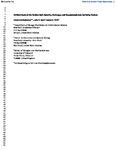Artificial reefs in the Arabian Gulf: Benefits, challenges and recommendations for policy-makers
| dc.contributor.author | Bartholomew, A | |
| dc.contributor.author | Burt, JA | |
| dc.contributor.author | Firth, Louise | |
| dc.date.accessioned | 2023-02-15T20:12:50Z | |
| dc.date.available | 2023-02-15T20:12:50Z | |
| dc.date.issued | 2022-11 | |
| dc.identifier.issn | 2352-4855 | |
| dc.identifier.issn | 2352-4855 | |
| dc.identifier.other | 102723 | |
| dc.identifier.uri | http://hdl.handle.net/10026.1/20402 | |
| dc.description.abstract |
Artificial reef (AR) deployment has increased dramatically in the Arabian / Persian Gulf in recent years, and will likely continue as Gulf nations continue to develop their coastlines and expand fisheries. Unfortunately, there is little publicly-available information about AR programs in the Gulf, including information about management goals and program success. ARs can provide economic, social and ecological benefits, but they also have underappreciated risks associated with them. Benefits include increasing short-term catch rates for fisheries, increasing tourism, enhancing and protecting biodiversity and providing ecological services. Risks include exacerbating regional overfishing in the long-term, facilitating the spread of invasive species, altering benthic habitat around the AR, contributing to marine pollution and creating habitats that are “sinks” for larval fish. This paper provides recommendations for managers that are considering whether to initiate AR programs in the Arabian Gulf. Deployment of ARs should not be used as an excuse to allow the destruction or degradation of natural habitat, since ARs are not surrogates of natural habitat. Managers should define clear, explicit management goals in the planning stages of the reef project, and then design and deploy the reef to meet those particular goals. Managers should also set quantifiable objectives for each goal, and implement long-term monitoring programs to determine whether the reef is successful in meeting its goals. Finally, managers should disseminate the results of the monitoring program and share “lessons learned”. Implementation of these recommendations will help to guide future sustainable AR programs in the Arabian Gulf and elsewhere. | |
| dc.format.extent | 102723-102723 | |
| dc.language | en | |
| dc.language.iso | en | |
| dc.publisher | Elsevier | |
| dc.subject | 14 Life Below Water | |
| dc.title | Artificial reefs in the Arabian Gulf: Benefits, challenges and recommendations for policy-makers | |
| dc.type | journal-article | |
| dc.type | Review | |
| dc.type | Journal | |
| plymouth.volume | 56 | |
| plymouth.publication-status | Published | |
| plymouth.journal | Regional Studies in Marine Science | |
| dc.identifier.doi | 10.1016/j.rsma.2022.102723 | |
| plymouth.organisational-group | /Plymouth | |
| plymouth.organisational-group | /Plymouth/Faculty of Science and Engineering | |
| plymouth.organisational-group | /Plymouth/Faculty of Science and Engineering/School of Biological and Marine Sciences | |
| plymouth.organisational-group | /Plymouth/REF 2021 Researchers by UoA | |
| plymouth.organisational-group | /Plymouth/REF 2021 Researchers by UoA/UoA07 Earth Systems and Environmental Sciences | |
| plymouth.organisational-group | /Plymouth/Users by role | |
| plymouth.organisational-group | /Plymouth/Users by role/Academics | |
| dcterms.dateAccepted | 2022-10-31 | |
| dc.rights.embargodate | 2023-11-17 | |
| dc.identifier.eissn | 2352-4855 | |
| dc.rights.embargoperiod | Not known | |
| rioxxterms.versionofrecord | 10.1016/j.rsma.2022.102723 | |
| rioxxterms.licenseref.uri | http://www.rioxx.net/licenses/all-rights-reserved | |
| rioxxterms.type | Journal Article/Review |


